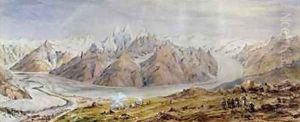Henry Haversham Godwin-Austen Paintings
Henry Haversham Godwin-Austen, not primarily known as an artist but rather as a British geologist, topographer, and surveyor, was born on July 6, 1834, in Teignmouth, Devon, England. He is most renowned for his exploration and survey work in India, particularly in the region of the Karakoram mountain range. The second highest peak in the world, K2, was once named Mount Godwin-Austen in his honor, due to his contributions to its surveying.
Godwin-Austen was the son of Sir Henry Edward Austen, an army officer, and he followed in his father's footsteps by attending the Royal Military Academy, Woolwich. After his graduation, he was commissioned into the British Army and served in the Royal Engineers. His military career, however, soon took a turn towards exploration and surveying, which became his lifelong passion.
His most significant contributions came during his service with the Great Trigonometrical Survey of India, where his expertise in geology and natural history greatly enhanced the quality and scope of the survey's findings. Godwin-Austen's work in the Karakoram range led to the mapping of glaciers and the naming of various geographical features. His extensive studies on the region's natural history also resulted in significant contributions to the fields of malacology and ornithology.
Godwin-Austen retired from the army in 1883 and returned to England, where he continued his scientific studies and wrote extensively on his experiences and findings in the Karakoram. He was a fellow of multiple scientific societies, including the Royal Geographical Society and the Geological Society of London.
Despite his multifaceted career, Godwin-Austen's contributions to art would be indirect, largely through his detailed topographical drawings and maps that have served as historical documents and as inspiration for artists interested in the grandeur of the Karakoram range and the natural world. He died on December 2, 1923, in Haslemere, Surrey, England, leaving behind a legacy of exploration and scientific enquiry that has had a lasting impact on the fields of geology, cartography, and natural history.
